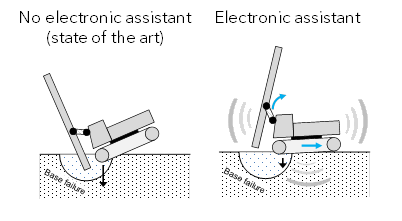Internationale Partnersuche
Innovation & Technologie Angebot
Adaptive numerical safety assistant system for the stabilization of construction vehicles with high center of gravity
Country of Origin: Germany
Reference Number: TODE20180213004
Publication Date: 15 February 2018
Summary
This Electronic Stability Control (ESC) system developed by a Technical University from Northern Germany prevents construction vehicles with high center of gravity from tip over in cases of sudden sagging of unfortified grounds. Transfer of rights, license agreements or R&D cooperation are offered to industrial partners with an interest to commercialize the technology, e.g. producers of chain-driven big machinery like excavators, drilling vehicles, crawler cranes, diaphragm wall cutters etc.
Description
Construction vehicles with a high center of gravity are vulnerable to tip over in cases of sudden sagging of unfortified grounds which they operate on. Currently, safe vehicle operation mostly relies on the experience and proper training of the driver. Technical solutions for driver support mostly focus on measuring working parameters of the vehicle, e.g. tilting, accelerations, ground pressure, and others. However, such solutions are not coupled yet with active counter-measures to avoid running into critical operation states near or beyond the point of no return for a toppling over of the vehicle.
The core of this invention therefore is a new assistant system for the vehicle driver, which keeps the vehicle in a safe operation state by measuring kinematic parameters. If the system detects operation in a critical regime, it automatically triggers suitable counter-measures to re-stabilize the vehicle and to protect its driver.
The assistant system is based on a kinematic model, established by numerical simulations. The model includes typical fingerprints for tipping behavior of chain-driven vehicles on unfortified grounds.
Sensors permanently monitor vehicle parameters during operation, e.g. tilt, acceleration. This data is fed into the vehicle system computer to calculate an immediate response based on the numerical model.
If a typical fingerprint indicative of a critical state is detected, the system (1) warns the driver of immediate danger, (2) it actively compensates critical movements via a fast control of the vehicle chassis, slew ring, and tools, (3) if tip over is inevitable, the system triggers protective measures for the driver, e.g. moving driver cab out of the danger zone or activating outriggers.
The ESC system can be integrated in all construction vehicles with high center of gravity especially excavators, drilling vehicles, crawler cranes or diaphragm wall cutters.
The patented technology is offered for license agreements or transfer of rights. The University is also open to discuss R&D cooperation with industrial partners, if they envisage licensing or transfer of rights but previously want to work on further development to market readyness in a common project.

Advantages and Innovations
1. Cost reduction by avoiding damage or loss of expensive equipment. Reduction of down-times of vehicles and at construction sites due to rescue operations.
2. Avoiding severe accidents and fatalities by better protection of the driver and support of his decision-making. Improved compliance in construction projects with respect to health, safety, and environment.
Stage Of Development
Under development/lab tested
Requested partner
Partners with an interest to commercialize this technology are sought. Focus is on vehicle manufacturers or component suppliers from construction sector. The technology would especially give an added value to chain-driven construction vehicles with high center of gravity, thus contacts to manufacturers of this kind of heavy machinery are sought.
Cooperation offer ist closed for requests

